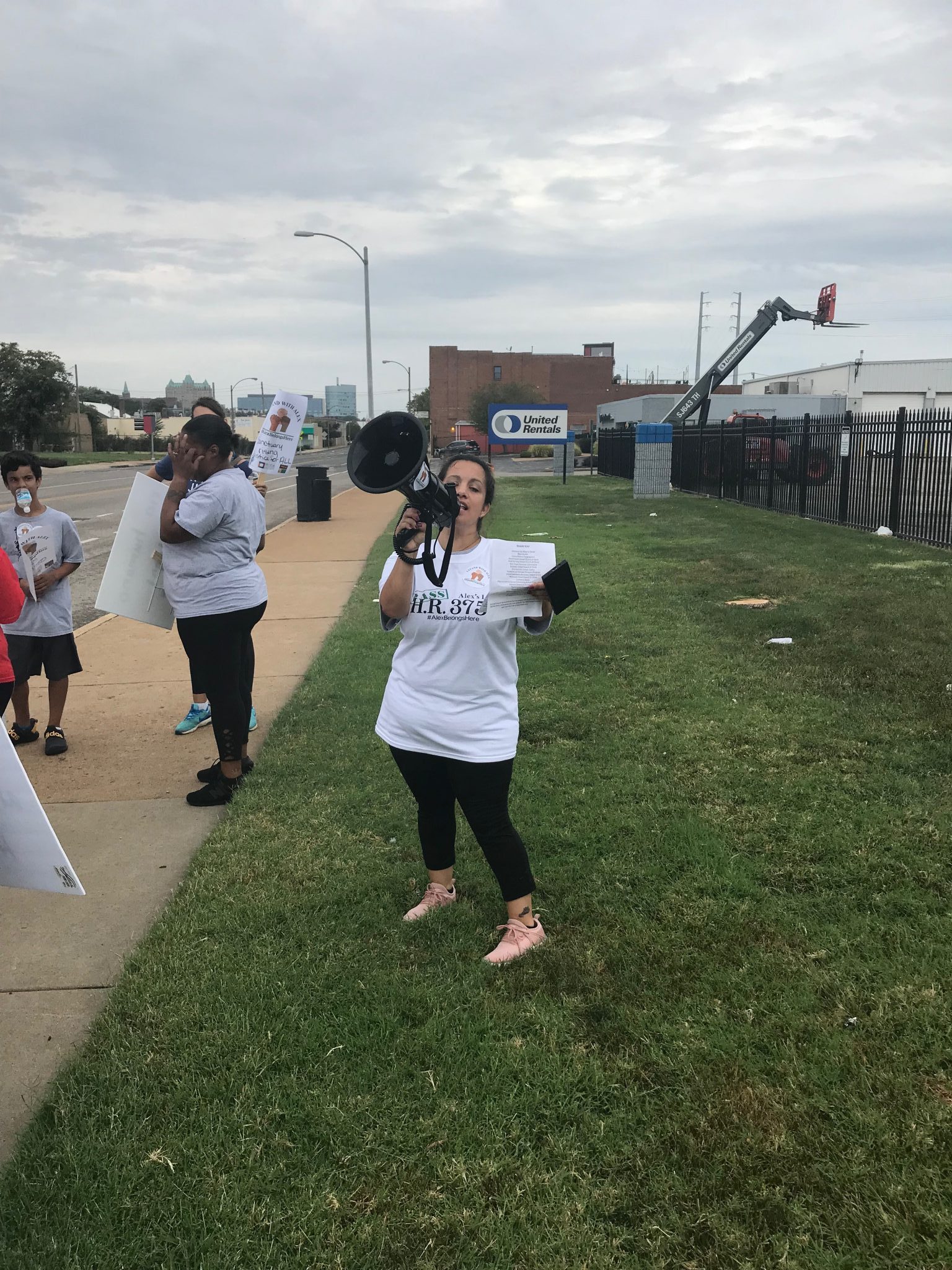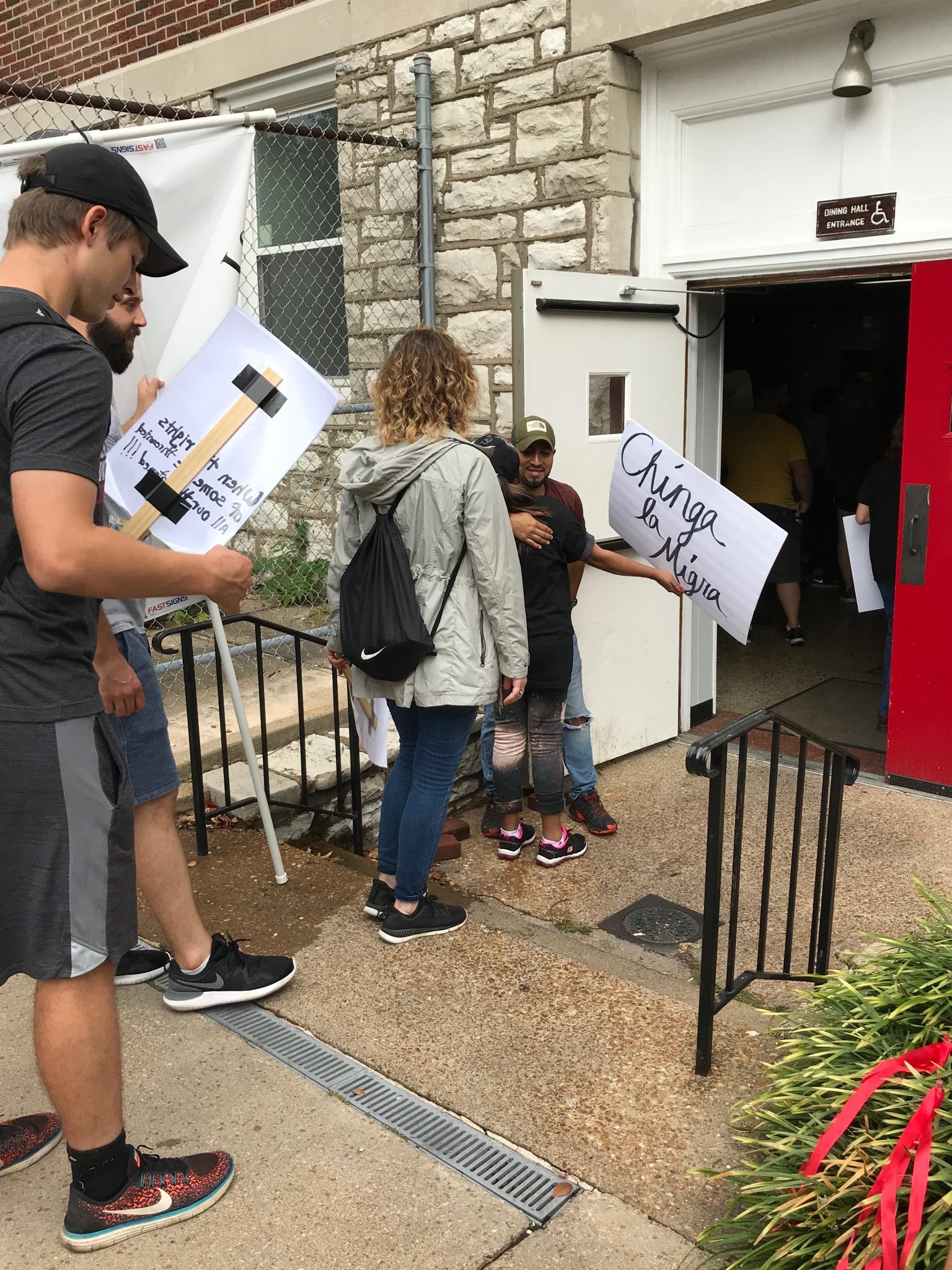

The start of the pilgrimage for Alex García Saturday in St. Louis. (Photo by Carlos Ruiz/Latino Rebels)
ST. LOUIS — “Today we pray with our feet. We offer 14,000 steps of joyful resistance,” intoned a solemn chorus of approximately 60 people gathered on Saturday outside of the Robert A. Young Federal Building.
The building houses the city’s U.S. Immigration and Customs Enforcement (ICE) field office. The interfaith group was gathered there to begin a pilgrimage in honor of the two years that Alex García, a native of Honduras, has been living in sanctuary at Christ Church UCC in Maplewood, Missouri, a nearby suburb.
The pilgrimage was jointly organized by Christ Church and the St. Louis Interfaith Committee on Latin America (IFCLA), a local nonprofit that in 2017 began organizing and preparing congregations for the latent possibility that sanctuary would be a necessary tool of resistance during the Trump Administration.
Before taking their first steps, the pilgrims raised their hands toward the federal building and participated in an interfaith prayer.
“We know that the spirit will help us to soften the hearts of our government, politicians, and all people so that very soon we can have new laws and policies that protect the dignity of all,” they collectively prayed.
After the prayer, Carly García, Alex’s wife, led the pilgrimage from the ICE field office to Christ Church. As she led the pilgrimage, megaphone in hand, Carly wore a shirt that read “Pass Alex’s Law H.R. 3750.” Her shirt referenced a private bill that was introduced by Congressman Lacy Clay on July 12, 2019. The bill would provide Alex García deportation relief, a pathway to residency, and eventual citizenship.


Carly García on Saturday in St. Louis. (Photo by Carlos Ruiz/Latino Rebels)
Although Carly is a U.S. citizen, Alex is currently unable to adjust his status due to a previous deportation. In 2000, Alex attempted to enter the United States. He was apprehended while crossing the U.S.-Mexico border and deported to Honduras. In 2015, he was once again detained while accompanying his sister to an ICE check-in in Kansas City.
After this second apprehension, he received two stays of removal that provided him temporary relief. In July of 2017, Alex and his attorney Nicole Cortes filed for a third stay of removal. Yet according to Cortes in a July 2019 press conference, “They denied that request. He was given a date to report for removal in September of 2017.”
The denial reflected a broader enforcement pattern under the current administration. Within his first months in office, Donald Trump signed a slew of executive orders on immigration, including executive order #13768 (“Enhancing Public Safety in the Interior of the United States”). The order gave immigration enforcement officials broad discretion to decide who was a priority for deportation, effectively putting all undocumented immigrants at risk. This was a more extreme difference from the previous administration, which generally focused on deportation of immigrants with criminal histories. Although Alex had been guilty of a DWI from 2008, that record had not prevented him from receiving multiple discretionary stays in the past.
The pilgrims marched for seven miles, and completed the procession in three hours. At each mile marker along the way, they were met by groups that supported the procession by providing cheers, snacks and water. These groups included representatives from local non-profits, community members, and a significant number of sisters from various Catholic religious orders.
Once the pilgrims arrived at Christ Church, they were greeted by Alex. In a striking gesture of hospitality, he welcomed each pilgrim into the church’s basement with a hug or a handshake.


Alex García greets supporters on Saturday at Christ Church UCC in Maplewood, Missouri. (Photo by Carlos Ruiz/Latino Rebels)
Breaking his usually demure character, Alex stood in front of the pilgrims with a microphone and tearfully delivered a paused and emotional speech: “Seeing you guys’ support makes us keep going. Thank all of you for marching with my wife Carly. And showing your support for me and my family. These two years have been really hard for me, not being able to leave the church so that I can work and provide for my family. And I pray that our administration sees that I belong with my family and they allow me to stay. Thank you, thank you so much, we couldn’t have done it without you guys.” The pilgrimage ended with a celebratory lunch of pupusas and tamales at the church.
It was perhaps a renewed impetus to keep fighting that was the most important outcome of the pilgrimage. Congressman Lacy Clay’s introduction of Alex’s private bill provides an important glimmer of hope for the Garcías. However, the bill’s journey toward passage into law is an arduous one, given the realities of a Republican-controlled Senate and a sitting president who has made his anti-immigrant positions clear.
Despite the odds, the Garcías and their advocates remain steadfast in their hope for Alex’s deportation relief. They have powerful and committed advocates like Sara John, the Executive Director of the St. Louis Interfaith Committee on Latin America and who is leading the advocacy strategy for Alex’s case. In the July 2019 announcement of the Alex’s private bill, John said, “This has been an uphill battle since our government looked at this woman [Carly] and told her that she doesn’t matter. So yeah, that’s a shitty space to be in, and we know it’s hard. And that has not prevented us and will not prevent us from exploring every avenue available to us within the law.”
The day after the pilgrimage, Carly delivered some brief remarks during Sunday service at Christ Church, where she, Alex, and their five children are now members.
“Today I’m exhausted. Seven miles will do that to you. I did it and asked everyone else to do it so that I can show people that we’re stuck here, we’re still fighting. We’re not going to stop. No matter how much they beat us down. Sore, bloody, sweaty, for this man [Alex] I’ll do anything,” she said.
Each step in the humid and overcast St. Louis morning was indeed a form of resistance to the Trump Administration’s anti-immigrant policies. The sanctuary efforts and the family’s determination have allowed Alex to remain in the country. Alex and Carly are leading a moral battle for their family’s right to remain together.


One of Alex García’s supporters on Saturday in St. Louis. (Photo by Carlos Ruiz/Latino Rebels)
The pilgrimage also teaches us an important lesson about the American religious landscape. In 2016, Donald Trump carried the Protestant and Catholic vote (including an overwhelming 77% of the white Evangelical vote and 64% of the white non-Hispanic Catholic vote). To be sure, these figures continue to be contested and analyzed. When we account for race and include a more diverse range of religions, the story becomes even more complex. However, these figures have helped conflate religiosity with political conservatism in the American popular imagination.
The participants in Saturday’s pilgrimage are part of a historically situated and growing movement of left-leaning religious progressives who are fighting back against the Trump Administration’s policies. Consequently, they are challenging the narrative of what it means to be religious in America today.
In August of 2017, a group of clergy led a counter protest against the Unite the Right Rally, a white supremacist march that took place in Charlottesville, Virginia. In St. Louis, faith leaders such as the Reverend Traci Blackmon continue to be vocal about issues of social justice. Just last week, Rev. Blackmon delivered remarks against gun violence in St. Louis. Although Rev. Blackmon has been actively involved with issues of social justice for decades, she came into the national spotlight after the murder of Michael Brown by a Ferguson, Missouri, police officer in 2014.


A Catholic nun provides snacks and water for supporters of Alex García (Photo by Carlos Ruiz/Latino Rebels)
There are signs that Democratic presidential candidates are taking note of the increasingly visible religious left. When Julian Castro announced in a speech that he was running for president, he pointed across the street to Our Lady of Guadalupe Catholic Church in San Antonio, Texas. He made it a point to mention that he was baptized there. Previously, when he announced in an interview that he was forming an exploratory committee, he sat beside a small but conspicuously placed statue of La Virgen de Guadalupe, a material representation of his faith. Likewise, fellow presidential hopeful Pete Buttigieg has not been shy about his deep Episcopalian faith.
Passage of Alex’s Law —or even broader immigration reform— would seem to defy the logic of our contemporary political moment. Yet the Garcías and the pilgrims who walked alongside Carly continue to bear witness to the immoral immigration policies of the Trump Administration. They lean on religious motifs and point toward a higher moral order to keep hope alive. By embarking on a pilgrimage, they remind us of Alex’s ongoing struggle. A struggle that has been ongoing for two years too long.
While the pilgrimage was a public form of protest and resistance, the Garcías resist each and every day in mundane yet powerful ways. Each morning, Alex wakes up at the crack of dawn and helps with tasks around the church. He is not required to do so, but he labors at the church to keep himself occupied while he remains entrapped within the walls of Christ Church. Sanctuary, while a temporary solution to immoral policies, remains a form of confinement. Carly resists each day by going to work, taking her children to school, and tirelessly advocating for her family’s right to remain together.
This weekend, Carly prayed with her feet. Protest took the form of 14,000 steps of joyful —and some might say sacred— resistance.
***
Carlos Ruiz is a PhD student in the Department of Religious Studies at the University of Iowa. He studies Mexican American Catholicism in the Midwest and the U.S. Sanctuary Movement. He tweets from @CarlosIRuizM.


